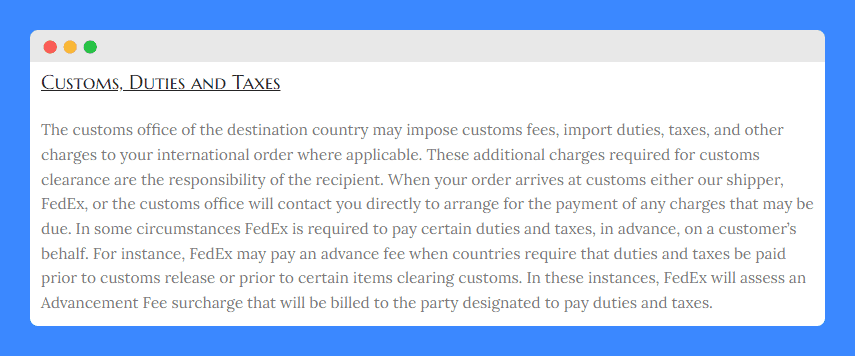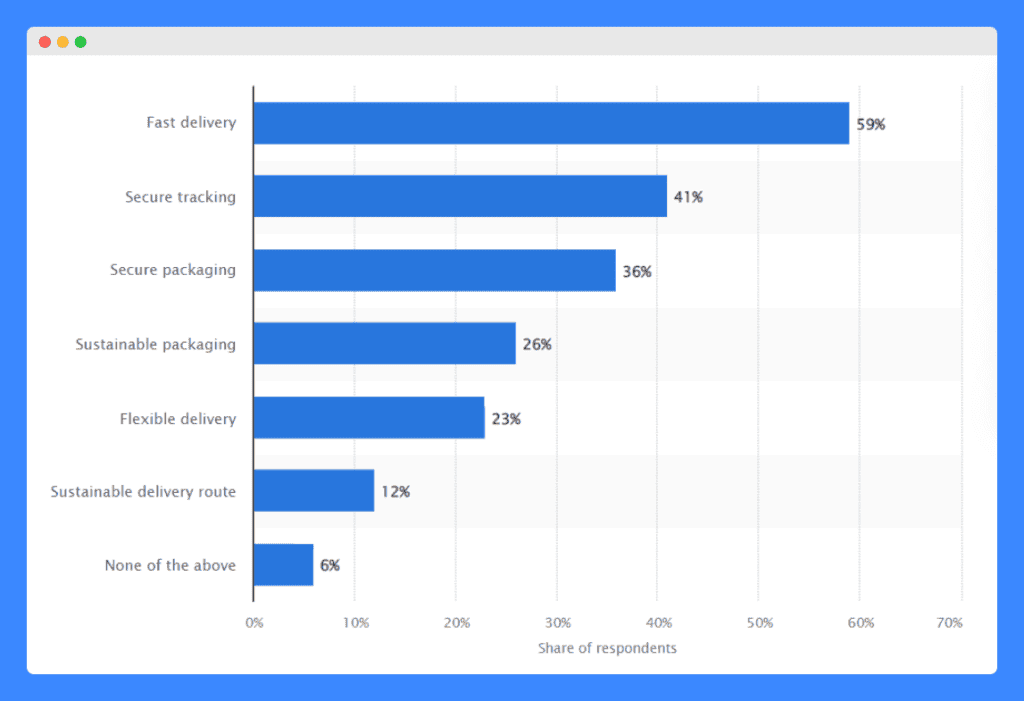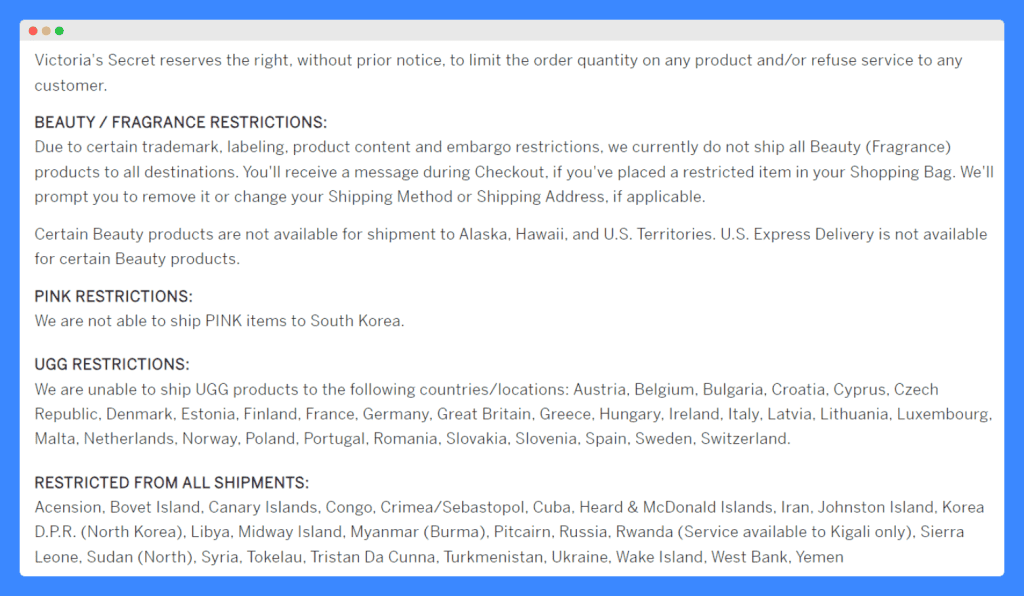Have you ever lost a sale because a customer was unsure about shipping costs? If so, you need a shipping policy for your online store.
A well-crafted shipping policy is a set of guidelines that informs customers about what to expect when they order from you. It clarifies delivery timelines, costs, and procedures, creating a smooth and transparent shopping experience.
In short, it can be the difference between a frustrated customer and a loyal one. Good thing, learning how to write a shipping policy for your business is easy.
Below, I’ll walk you through the process of writing one, provide tips for crafting a clear and effective policy designed for your business, and explore the pros and cons of writing your own versus using a template.
- Your shipping policy should be easy to understand and outline all the essential details like costs, timeframes, and restrictions.
- Link to the shipping policy prominently on your website so your customers can easily find it before they complete their purchase.
- It’s best to use a reliable shipping policy generator to tailor the policy to your needs and how you operate.
Table of Contents
PRO TIP: Take the hassle of writing your own shipping policy away with our shipping policy generator trusted by over 200,000 businesses. It’ll save you hours of work and help increase sales in minutes.
How To Write a Shipping Policy
For the uninformed, writing a shipping policy may seem daunting. To get you on the right track, let me break down the process into manageable steps that cover everything from choosing shipping methods to defining customer responsibilities.
By following these steps, you’ll ensure your shipping policy covers all necessary details, setting your eCommerce business up for success.
1. Overview of Shipping Methods
Having a clear shipping policy on your eCommerce platform allows customers to make informed decisions based on their needs and budget. To make sure you do this, it should include the different shipping options you’ll offer.
This could include standard shipping (taking a set number of business days), expedited shipping (faster delivery at a higher cost), specialty services like refrigerated shipping for perishable items, or even overnight delivery for urgent purchases.
Here is a snippet from Acadental’s shipping policy outlining the expected delivery times depending on the shipping option:

Consider your target audience and product types when making these choices. For example, if you sell fragile items, you might want to offer insured shipping as an option.
2. Shipping Costs and Calculation Method
Next, determine your approach to shipping costs. Be transparent about any standard shipping charges, considering weight, dimensions, and destination. For international shipping rates, you’ll need to factor in additional costs like customs and duties.
Clearly explain how you calculate shipping costs, whether it’s a flat rate, weight-based, or location-dependent. This transparency allows customers to estimate their total order cost upfront.
If possible, offer free shipping under certain conditions, such as orders over a specific dollar amount or promotional periods. This can be an incentive for customers to increase their order size or choose your store over competitors.
3. Geographic Limitations and International Shipping
Clearly state which countries or regions your eCommerce business is able to serve. For instance, if you offer international shipping options, specify which international destinations are included and any notable exclusions.
Provide a shipping information example, such as detailing that while you ship internationally to countries like Canada and the UK, there might be restrictions or additional charges for locations such as remote islands.
Here’s an example of a shipping policy that covers international shipping:

By adding this section, Gemrize sets clear expectations for customers outside their primary market and ensures they are aware of any potential limitations or additional requirements.
4. Delivery Time Estimates
In a January 2022 survey, 59 percent of US and UK respondents cited fast delivery as a defining feature influencing their shopping behavior, alongside secure tracking and proper packaging.

This means you want to be as transparent as possible when it comes to letting customers know what to expect in terms of shipping times for different methods and destinations.
Also, address any potential shipping delays. Inform customers of possible longer wait times during high-demand periods or due to logistical challenges.
5. Order Processing Times
It’s important to include in your shipping policy how your store processes orders before they are shipped. Clearly define the time it takes to prepare the order for shipment, which may include tasks like picking, packing, and quality checks.
For example, you might state that orders are processed within 1-3 business days under normal conditions. Then, highlight any factors that could extend processing times, such as high order volumes during sales or holidays.
6. Shipping Carrier Information
Your shipping policy should include information on which carriers are partnered with your business, such as USPS, FedEx, UPS, or any other local or international courier services.
Detail the different services each carrier offers, like ground shipping, express delivery, or special handling options. This section should also explain how the choice of carrier may affect delivery times and costs.
7. Tracking Order Shipments
Make sure you communicate essential shipping details such as how and when tracking numbers are provided, which carriers offer tracking, and how customers can use these numbers to check the progress of their shipments.
Here’s how Youtooz makes sure their customers know how to track their orders:

If you work with multiple shipping carriers, explain how customers can identify which carrier is handling their specific package and how to access their tracking information.
An Order Tracking section is important to include on your shipping policy, as it helps reduce customer anxiety by keeping them informed every step of the way.
8. Shipping Restrictions and Special Conditions
Dedicate a clause in your shipping policy that details the main shipping restrictions, such as prohibited items, restricted areas, or limitations due to the size and weight of products.
Here’s a shipping policy example from Victoria’s Secret covering shipping restrictions:

It’s also a good idea to clarify any special conditions that affect how products are shipped, like hazardous materials requiring special packaging.
Don’t forget to discuss return shipping policies, outlining how returns are handled, who bears the cost, and any conditions that must be met for a successful return. This transparency helps avoid confusion and ensures smoother transactions.
9. Customer Responsibilities on Delivery
A great shipping policy isn’t just about what you, the business, offer – it also outlines customer responsibilities upon delivery. Include a clear clause within your shipping policy page that outlines these expectations.
As Amazon’s founder, Jeff Bezos, famously said,
“We see our customers as invited guests to a party, and we are the hosts. It’s our job every day to make every important aspect of the customer experience a little bit better.”
While this emphasizes the importance of service, it also implies that customers have roles to fulfill. Specify what is expected of customers, such as ensuring someone is available to receive the delivery or providing a secure location for package drop-off.
One of the benefits of having a shipping policy that clearly defines these responsibilities is that it prevents disputes and misunderstandings.
10. Policy Updates and Modifications
A shipping policy is a living document that may require adjustments as your business evolves or as external conditions change. Make sure to have a policy in place that outlines how and when the shipping process will be updated.
This could include changes due to new shipping partnerships, adjustments in shipping rates, or modifications in delivery areas.
Encourage your customers to review your shipping policy periodically. This ensures that both you and your customers are always on the same page.
Tips for Writing a Bulletproof Shipping Policy
Writing a bulletproof shipping policy requires attention to detail and a deep understanding of your customer’s expectations. Your goal should be to make your shipping policy the cornerstone of your eCommerce operations.
Here are some essential tips and best practices to guarantee that your shipping policy does just that:
Use clear, straightforward language
The eCommerce shipping policy on your website should avoid jargon and legal language that might confuse customers. It should be easily understandable by everyone who shops on your site.
Highlight key points
Use bullet points or bold text to highlight critical elements such as shipping fees imposed during or after shipping, delivery times, and special conditions. This formatting makes the information more accessible and helps customers quickly find the details they care most about.
Consolidate return and exchange policies
Include a link or a brief overview of your return and refund policy on the same page as your shipping policy. Customers should be able to easily find and understand all the necessary information before they complete their purchase.
Offer examples
Provide examples of common scenarios in your shipping and return processes. This can help clarify what customers can expect in various situations, such as delays or processing returns.
Keep it updated
Update your shipping policy every time there are changes in shipping logistics and legal requirements to make sure they remain accurate.
Dos and Don’ts When Creating Shipping Policy for Your Website
It’s not enough that you learn how to write shipping policies for eCommerce websites. You also have to consider what you should do and what you should avoid.
These dos and don’ts provide a roadmap to help you do that effectively:
Dos
- The shipping page must outline the steps involved in your shipping process. This way, your customers know what to expect when they buy from you.
- Use a template only as a starting point. While a template that you can use might streamline the process, always customize it to fit your specific business needs and legal requirements.
- Include links to related policies, such as your exchange and return policies and privacy policy, to provide a comprehensive resource for your customers.
- As your business evolves, so should your shipping policy. Make sure to keep it updated to reflect changes in shipping practices, costs, or legal requirements.
- Ensure that your shipping policy is easily readable on mobile devices. Many customers shop and read policies on their phones.
Don’ts
- Avoid burying your shipping policy in hard-to-find areas of your website. It should be easily accessible from the shipping page, footer, or main menu.
- Don’t use complicated language. A policy doesn’t need to be filled with legal jargon to be effective. Clarity is key.
- Don’t ignore international laws: If you ship internationally, be aware of and comply with international shipping laws and regulations that may affect your business.
Aside from ensuring your shipping policy is easily understandable, make it easy to find. Even a great policy becomes useless if customers struggle to find it.
The Pros and Cons of Writing Your Own Shipping Policy
Deciding whether to write your own shipping policy can significantly impact the effectiveness of your eCommerce operations.
Let’s explore the advantages and disadvantages of crafting your own policy versus relying on ready-made templates:
Pros
- Customization: Writing your policy allows you to tailor the terms specifically to your business needs, covering unique domestic and international shipping costs and delivery times.
- Brand Voice Consistency: Your own policy can reflect your brand’s tone and approach, providing a more seamless customer experience.
- Flexibility: You can quickly adapt and update your policy to changes in your business model or external shipping conditions without needing to fit a template’s constraints.
Cons
- Time and Effort: Crafting your own policy requires more time and effort than simply adapting a shipping policy template and examples.
- Legal Expertise: Without legal expertise, you might miss essential legal requirements, which can lead to compliance issues.
- Oversights: There’s a risk of omitting important clauses that a template would typically include. You might unintentionally delete it from the template, causing potential issues.
A Faster Way To Write Your Shipping Policy
While you can use a sample shipping policy template to help you get started, it’s not always recommended. Writing your own is also not for everyone, as many don’t have the legal expertise needed to make the policy effective and bulletproof.
If you ask me, the best approach is to use a shipping policy generator instead. With one, you can create a shipping policy that not only meets legal requirements but also supports your business objectives and customer needs.
But what is a shipping policy generator, anyway?
A shipping policy generator is a tool designed to streamline the creation of a standard shipping policy for online stores. It offers a structured framework that covers all essential elements, ensuring compliance and completeness without the need for extensive legal knowledge.
By using our shipping policy generator, you can efficiently produce a robust policy from start to finish, saving time and reducing the risk of omitting important information.
Frequently Asked Questions
Do I need a lawyer to write a shipping policy for me?
Hiring a lawyer to write a shipping policy isn’t always necessary. With the right shipping policy generator, you can craft a strong policy to protect your business.
What are the advantages of using an online shipping policy generator?
An online shipping policy generator, like ours, saves time and ensures your policy covers all legal bases. It simplifies creating detailed, compliant policies.
Can I copy a shipping policy from another website?
Copying a shipping policy from another website isn’t advisable as each business has a unique shipping and returns process. Use a policy generator to create a customized policy.
How often should I update my shipping policy?
Review and update your shipping and delivery policy annually or when major changes occur. Regular updates ensure accuracy and compliance.
What happens if I don’t have a shipping policy?
Not having a shipping policy can lead to misunderstandings and disputes with customers. It’s crucial to have a clear policy to set the right expectations and ensure smooth transactions.



